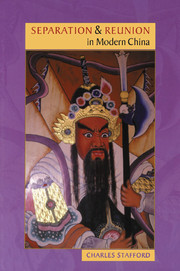Book contents
- Frontmatter
- Contents
- Acknowledgements
- Introduction: an anthropology of separation
- 1 Two festivals of reunion
- 2 The etiquette of parting and return
- 3 Greeting and sending-off the dead
- 4 The ambivalent threshold
- 5 Commensality as reunion
- 6 Women and the obligation to return
- 7 Developing a sense of history
- 8 Classical narratives of separation and reunion
- 9 The politics of separation and reunion in China and Taiwan
- Conclusion: the separation constraint
- Notes
- References
- Index
Introduction: an anthropology of separation
Published online by Cambridge University Press: 22 September 2009
- Frontmatter
- Contents
- Acknowledgements
- Introduction: an anthropology of separation
- 1 Two festivals of reunion
- 2 The etiquette of parting and return
- 3 Greeting and sending-off the dead
- 4 The ambivalent threshold
- 5 Commensality as reunion
- 6 Women and the obligation to return
- 7 Developing a sense of history
- 8 Classical narratives of separation and reunion
- 9 The politics of separation and reunion in China and Taiwan
- Conclusion: the separation constraint
- Notes
- References
- Index
Summary
After the separation of death, one can eventually swallow back one's grief; but the separation of the living is an endless, unappeasable anxiety.
Tu Fu, Tang dynasty poet (eighth century AD)When two friends or relatives meet who have been separated from one another for a few weeks or longer, they greet each other by sitting down, one on the lap of the other, with their arms around each other's necks, and weeping and wailing for two or three minutes till they are tired. Two brothers greet each other in this way, and so do father and son, mother and son, mother and daughter, and husband and wife. When husband and wife meet, it is the man who sits on the lap of the woman. When two friends part from one another, one of them lifts up the hand of the other towards his mouth and gently blows on it.
A. R. Radcliffe-Brown, The Andaman IslandersThis book ends with a local matter, so-called: the passions aroused by the potential reunification of Taiwan with mainland China. Dangerous territory! But it begins very differently, with a ‘universalist’ hypothesis: that the existential constraint of death (which anthropologists since Frazer have repeatedly discussed), is merely a subset of the existential constraint of separation (which anthropologists since Frazer have arguably … well, obscured – and thus in some ways ignored).
- Type
- Chapter
- Information
- Separation and Reunion in Modern China , pp. 1 - 29Publisher: Cambridge University PressPrint publication year: 2000



